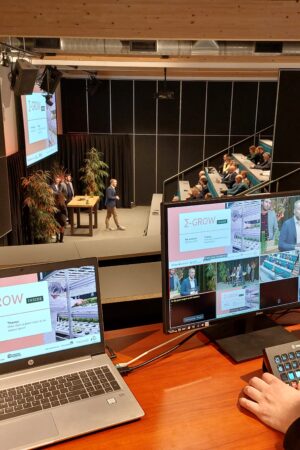For over 30 years MJ-Tech has been installing high-pressure fogging solutions in multiple applications; from livestock barns and industrial applications to many greenhouses-related set-ups. Cannabis cultivation belongs to one of the “younger” crops and quite some installations have been done for it in the last 5-10 years in North America and more recently Australia, Europe, and other locations come into play. It also varies from recreational purposes to medical-oriented purposes depending on the legal context applicable in a country. “There were not a lot of opportunities to go into detail how high-pressure fogging is applied (yet) and being a member of the CfC consortium provides chances to create more insights.”
For this interview, we got in touch with Rob Kwinten, Business Development Manager at MJ-Tech. With years of experience focusing on the cannabis market, Rob’s daily attention is dedicated to cannabis cultivation, as well as vegetable and berry crops, worldwide; “We make sure our customers have the knowledge and understanding of how to use the fogging at certain greenhouse conditions and taken the outdoor conditions into account to apply the right settings in the climate computer.” Rob stressed the importance of knowing how and when to use a high-pressure fogging system “Some people do not realize the many strong and unique advantages of fogging, but one has to realize that when used wrong, it can ruin the crop”.
Rob mentioned that joining the CfC consortium had several benefits for MJ-Tech, with one of the key points to gain a better understanding how to use fogging correctly in cannabis greenhouse cultivation through the different growing phases: from mother plant production to propagation, vegetative, and flowering phase. “With each conducted trial, knowledge will be collected regarding the added values of fogging in combination with products of CfC partners in cannabis growing. For instance, can we build up a more resilient plant in the early development stages to have fewer issues during later cultivation phases? In general, the combined shared work, all the available and gained knowledge openly exchanged between the consortium partners, is a great opportunity to develop faster and better in the industry. Moreover, there is a business-oriented benefit as well. The marketing advantages a consortium like CfC offers are valuable. We strive to make sure everyone knows that MJ-Tech is active and knowledgeable in the international medical cannabis sphere. Finally, we know our clients will benefit from our participation in the CfC. As a company, we are not only providing the installation to the market, but it is accompanied by the right valuable knowledge and support.”

MJ-Tech conducted research and growing trials of many crops all over the world. “We have clients in the cannabis industry, and their results are mesmerizing, but we want to know more. If everything is perfect and known, you do not need research. Nonetheless, it is far from the reality, especially in such a young and developing industry as medicinal cannabis. Conducting research and trials is the time to make mistakes and learn from them, to be able to prevent your clients from making them.”
This inspiring statement led us to discuss the challenges of MJ-Tech during the CfC; “With the start of the project, the facility was built from scratch. It took us all some time to be able to reach a state where we have full control over climate and find the balance, such as knowing the optimal fogging settings in the climate computer. This was the first step and first struggle, which by now, we have overcome of course.”
Rob shared with us a few of the things MJ-Tech is paying closer attention to, as they would like to learn more about; “Is it possible to use fogging as a technique to create a stronger cannabis plant (i.e., more resilient against pests, diseases, and fungi, such as botrytis) while maintaining a consistent yield year-round? These are especially important for the demanding and strict medicinal market. Another thing is, with other crops, for example, cucumbers, it is known when fogging is used correctly. Therefore, they would like to know, can it happen with cannabis too?”
To research all aspects Rob mentioned above, some adjustments in the fogging settings must take place during the trials. “Fogging is strongly dependent and cannot be modified simply because the team wants to, it must be done in a balanced manner. Therefore, based on the findings of each growing cycle, we made corrections, ensure the climate conditions are most favorable for the plants, and reassure the trials and research questions of the other participants will not be negatively affected by the adaptation.”
This raised an interesting question; What must be considered to determine whether fogging will have a negative impact on your trials? Rob explained, “There are a few points of attention concerning the climate conditions of course, nevertheless, the set-up plays an important role as well; what density the plants are growing at, the amount of micromole light, type of light (HPS, LED or hybrid light) , airflow in the facility, and growing system (e.g., tables or gutters), all these are affecting the fogging settings. Following these adjustments is very interesting for MJ-Tech to see what the impact of all these modifications on the plant and product quality will be.”
Looking into the future, MJ-Tech is expecting to achieve and fulfill its goals set prior to the start of the consortium and have a clear answer to all the questions set in advance, i.e., improve fogging settings to impact cultivation, improve plant quality, plant resilience, and achieve consistent yield and product quality. Likewise, from a technical point of view, reach a better understanding of the installation for the different possible goals. For instance, what nozzles should be used in different growing set-ups, what should be the amount of moisture that should be brought into the air during the different growth phases, and more.
Rob summarized, “By the end of CfC, we want to have created a step-by-step manual for our clients with all the information they should know to be able to apply correctly throughout annual multi-cycle cannabis production using a high-pressure fog system.”

* Cultivation for Compounds is partly funded by PPS surcharge for research and innovation from the Ministry of Economic affairs and climate.





